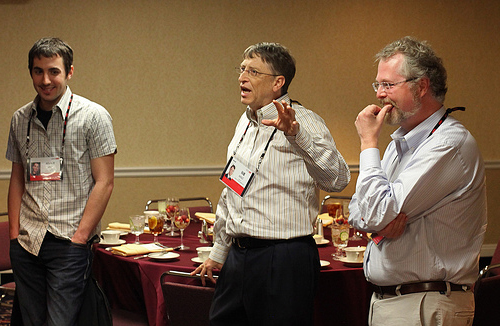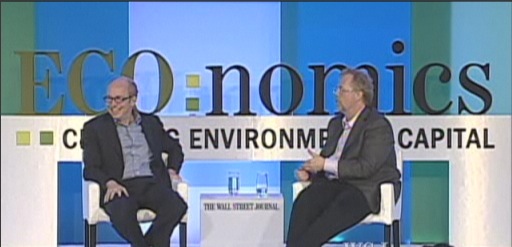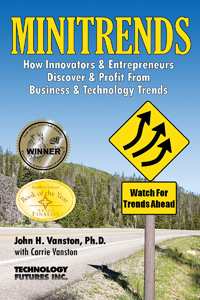Google, Yahoo Struggle with Technology Innovation
March 30, 2011
 Google is taking a slice from Apple’s strategy, bringing back company co-founder Larry Page to ignite innovation at Google, where the stock has flatlined for the past year. Page is scheduled to take over next week as CEO from Eric Schmidt, who is reportedly under consideration for the Secretary of Commerce position in U.S. President Barack Obama’s cabinet.
Google is taking a slice from Apple’s strategy, bringing back company co-founder Larry Page to ignite innovation at Google, where the stock has flatlined for the past year. Page is scheduled to take over next week as CEO from Eric Schmidt, who is reportedly under consideration for the Secretary of Commerce position in U.S. President Barack Obama’s cabinet.
It’s often difficult for mature companies to innovate the way startups do. For one thing, they lack the financial compulsion that drives entrepreneurs to market or die. Look at how News Corp. has shouldered losses at MySpace while Facebook restlessly innovates, or what happened to AOL after the merger with Time Warner, or what might happen to The Huffington Post now that it has been acquired by AOL. Google can afford to simply hold onto a company such as YouTube without the pace of self-improvement often seen in startups.
Amir Efrati, who covers the Internet for The Wall Street Journal, has been stirring things up in Silicon Valley this past week with fascinating reports on attempts by Google and Yahoo to stay innovative. In an article last Saturday, Efrati used unnamed sources to speculate that Larry Page is being called back to “speed up what [Page] says has been sluggish decision-making at Google’s top levels.”
One of Page’s new edicts, according to The Wall Street Journal, is face-to-face bullpen sessions:
… [E]very afternoon, [Page] and the company’s executive officers sit and work on small couches outside a boardroom in Building 43 at Google’s headquarters.
That might have worked when Page left the company in 2001, with 200 employees. Whether it will work 10 years later, with over 100 times as many people on the payroll, remains to be seen.
The difficulty of fostering innovation in mature companies is one of the main drivers behind the Minitrends project at Technology Futures, Inc., the Austin, Texas, technology forecasting firm and publisher of the book, MINITRENDS, and this blog. The authors devote a significant portion of the book to fostering innovation in large corporations:
Fewer than 30 percent of the companies listed on the Fortune 100 twenty-five years ago are still on the list today. Often the primary reason for the demise of such companies has been a failure to recognize and react to changing trends.
One of the ways that companies innovate is through acquisition rather than invention. Efrati generated a second round of buzz this week when he quoted Yahoo’s director of development, Steven Mitzenmacher, on The Wall Street Journal‘s Digits blog as saying Google’s investment in YouTube was “crazy.” It’s an odd comment, given YouTube’s burgeoning revenues and the fact that Yahoo is embarking on a buying binge to remain relevant.
Savvy institutional investing reporter, Riley McDermid, follows the fallout from Page’s return to Google in an insightful article at VentureBeat. Always one step ahead of the competition, McDermid managed to write about The Wall Street Journal‘s article a day before the article appeared. It’s hard to keep up with futurists!
So where do large corporations find the stimulation they need to stay at the forefront of technology trends? Among the resources mentioned in MINITRENDS are innovation competitions and working papers. Among the best examples of where to find both is the National Collegiate Inventors and Innovators Alliance (NCIIA), which held its version of “March Madness” — an innovation competition — in Washington, D.C., last Saturday.
The NCIIA competition is sponsored by companies that are working to stay competitive and rewarding innovation in education. The NCIIA has already published all the conference papers online, for free; they contain a treasure-trove of ideas for mature companies looking for a little stimulation or entrepreneurs looking for adventure.
If you prefer to watch rather than read, we recommend you screen the videos submitted to the NCIIA’s “Open Mind” Awards and nicely catalogued by David Orsman at Inventors Digest. It’s by doing research like this that you are likely to find the Larry Pages and Steve Jobs of tomorrow, who will set the technology trends that others follow.
STEVE O’KEEFE
News Editor, Minitrends Blog
Source: “Obama Nears Appointment Of Eric Schmidt As Commerce Secretary,” BusinessInsider, March 18, 2011
Source: “At Google, Page Aims to Clear Red Tape,” The Wall Street Journal,” March 26, 2011
Source: “Larry Page already cracking the whip at Google, a week before he takes the reins,” VentureBeat, March 25, 2011
Source: “Yahoo Executive Talks Acquisitions, Slams YouTube Buy,” The Wall Street Journal‘s Digits Blog, March 28, 2011
Source: “The Open Minds Awards: Taking Innovation off Campus & into Commercialization,” Inventors Digest, Feb. 18, 2011
Photo courtesy of Jeff Keyzer (mightyohm), used under its Creative Commons license.
Business Model Trends – The Good, The Bad, and The Ugly
March 22, 2011

Kevin Rose of Digg, Bill Gates of Microsoft, and Nathan Myhrvold of Intellectual Ventures at the TED Conference (Photo courtesy of Steve Jurvetson).
Two days before an earthquake measuring 9.0 on the Richter scale struck Japan, resulting in a devastating tsunami and near meltdown at the Fukushima nuclear power plant, we wrote on this blog about “the growing interest in nuclear power” as an alternative to coal fired power plants.
Oops!
While nuclear power-generating facilities have been greatly improved since the Fukushima reactors were built — and the prospects for nuclear energy in the future are still bright — the timing is bad. The prospects for nuclear energy in the short term have dimmed as the costs associated with using that technology are being recalculated.
That wasn’t the only thing wrong with my blog post. A reader called my attention to the case against venture capitalist Nathan Myhrvold’s company, Intellectual Ventures. Myhrvold is the former chief technology officer of Microsoft whose new company invests in technology rather than investing in companies. Intellectual Ventures buys the rights to patents it likes, then markets those patents to other firms. Or does it?
According to Mike Masnick, the prolific and outspoken editor of TechDirt, Myhrvold’s venture is not based on marketing patents but on “shaking down” companies by suing anyone using its patents without permission. Masnick accuses Intellectual Ventures of disguising its true business model by using shell companies to file the lawsuits:
[Intellectual Ventures] had decided to protect its brand name by getting other companies or creating those companies itself, giving the patent to those other companies that no one had ever heard of, and having them sue.
Ouch!
While we did praise Myhrvold’s business plan on this blog, his method for picking technologies to invest in was our focus, not his manner of collecting on those investments. However, without beating up on ourselves too much, we should point out that another company with a strikingly similar business plan has been the recipient of tremendous admiration in the media these past few weeks.
I’m speaking of ARM, the technology company behind the low-heat computer chips used in Apple’s iPhone and iPad, along with many other smartphones and tablets. The company is not bashful about its creative structure:
ARM has an innovative business model. Instead of bearing the costs associated with manufacturing, we license our technology to a network of partners, mainly leading semiconductor manufacturers and OEMs. These partners utilise our designs to create smart, low energy chips suitable for modern electronic devices.
This structure — licensing technology rather than manufacturing it — has led to a gross margin for ARM of 94%. With revenue of $631 million in 2010, ARM had a profit of $593 million. You have to envy that ratio, no matter what business you’re in.
ARM’s business model is similar to Intellectual Venture’s stated mission, yet while Myhrvold is the recipient of scorn from TechDirt and others, ARM is getting nothing but love these days. Renown technology strategist, Michael J. Fern, gushes over ARM’s business model, saying it confers “three significant advantages over Intel.”
The Wall Street Journal joined the praise parade, with University of Chicago-trained economist and new “Heard on the Street” columnist, Rolfe Winkler, noting “ARM… doesn’t have to deal with manufacturing costs or the risks of holding inventory. It’s a deeply profitable business.”
The best take on ARM’s business model, from a Minitrends perspective, comes from the recent article by Om Malik at the influential blog, GigaOM. In a post critical of Twitter’s business model, the highly-respected tech journalist compares and contrasts the business models of half-a-dozen tech companies, including Xerox, Apple, Google, and ARM. Relying heavily on the work of business guru Alex Osterwalder, Malik concludes that “the business model innovation is what turns great products into fearsome companies.”
Sometimes, the most beautiful business models can turn ugly down the road. I was teaching a workshop once when a perplexed attendee kept interrupting with questions. “How do you generate sales,” he asked. “I don’t have sales,” I answered, “I only have expenses. All I have to do is cover my expenses.”
I was describing the workings of a technology startup that made videos of businesses without charging those businesses. Costs were recouped by finding sponsors to cover the expenses. The fellow in the back of the room couldn’t understand the business model and, as it turns out, neither could investors or sponsors. An early online video play, the company died in 2008 for lack of revenue.
The clever idea of yesterday can seem brilliant or stupid a few years — or even a few days — later. That’s why, for your own Minitrends Adventure, we recommend spending as much time thinking about the business model as you do about the services or goods being sold.
STEVE O’KEEFE
News Editor, Minitrends Blog
Source: “Nathan Myhrvold on Uncovering and Investing in Technology Trends,” Mintrends Blog, March 9, 2011
Source: “Nathan Myhrvold’s Intellectual Ventures Using Over 1,000 Shell Companies To Hide Patent Shakedown,” TechDirt, Feb. 17, 2010
Source: “ARM Disrupting Intel with its Business Model?,” FernStrategy, March 10, 2011
Source: “Getting an ARM Up on Intel,” The Wall Street Journal, March 17, 2011
Source: “What Is Twitter’s Problem? No, It’s Not the Product,” GigaOM, March 8, 2011
Photo courtesy of Steve Jurvetson, used under its Creative Commons license.
Business Trends for Pets and “Petrepreneurs”
March 16, 2011
 We have covered many business trends on this blog that primarily affect humans, but we have been remiss in documenting trends related to our furry and feathered friends: household pets.
We have covered many business trends on this blog that primarily affect humans, but we have been remiss in documenting trends related to our furry and feathered friends: household pets.
Before you pass the iPad to your pooch, I should explain that these trends are very important to people, too. There are many promising opportunities in “petrepreneurship,” and many businesses that serve the needs of pet providers will need good information on where the market is headed.
Let’s start with a few facts courtesy of the American Pet Products Association. How big is the market? The most recent numbers available are for 2009-2010. It’s estimated that in 2010, Americans spent $47.7 million on their pets. An article on 24/7 Wall St combines that information with U.S. Census data to inform us that, “These expenses have increased from 0.9% of household budgets in 1989 to 1.4% in 2009.” That’s more than a 50% increase in the share of household budgets for pets in the last decade. Sounds like a growth industry to me.
In roughly the same time period, the number of U.S. households with pets has increased from 56% to 62%.
And what kind of pets, exactly, are we talking about? Even though more households have a dog than a cat, cats have the upper paw, with 93.6 million feline pets compared with 77.5 million canines. However, there are more pet fish than cats and dogs combined: 171.7 million of them swimming in American aquariums. Rounding out the menagerie are 15 million birds, 13 million horses, and, yesss, over 13 million reptiles.
According to the report, U.S. Pet Market Outlook 2010-2011: Tapping into Post-Recession Pet Parent Spending, Americans are expected to boost their pet spending to as much as $70 billion by 2014. One of the reasons cited is “a human/animal bond that is possibly stronger than ever as a result of the recession.” The report expects spending to increase on “ethical products,” such as “organic/natural, sustainable, humane, etc.”
The breakdown for the $45.5 billion American spent on their pets in 2009 is as follows:
- Food, $17.56 billion
- Supplies/OTC Medicine, $10.41 billion
- Vet Care, $12.04 billion
- Live Animal Purchases, $2.16 billion
- Pet Services: Grooming & Boarding, $3.36 billion
In an amazing article entitled “Pet Trends for 2011,” Laura Bennett, CEO of Embrace Pet Insurance, examines new developments in pet care, noting that “pet parents will cut back on their own expenses before those of their pets.” Here are some highlights:
- Wal-Mart will continue to roll out pet grooming facilities, competing with pet salons.
- “Disney has finally caught on to the trend of vacationers traveling with their pets, opening the Best Friends Pet Care luxury dog and cat resort right across from the Walt Disney World Resort.”
- Pet insurance will continue to surge in growth. “I expect overall premium growth of 14% in 2011 that will see the US pet insurance industry grow to $374 million in GWP [gross written premiums].”
- “Retailers such as Target and Costco are creeping into the domain of the veterinarian… Will 2011 be the year that the pet pharma market is burst open and veterinary hospitals cede billions of dollars in revenue and profit to the retail giants?”
Bennett goes on to cite five marketing trends for pet products that should sound familiar to readers of the Minitrends Blog — or any other blog on technology trends:
- Social Networking, including exclusive networks for “pet parents”
- Local Shopping Sites, including Yelp, which review pet product providers
- Pet Blogs, including Pet Connection, Pawcurious, and YesBiscuit!
According to Bennett, among the most needed services in the pet products industry (are you listening, petrepreneurs?) is the integration of e-commerce websites and social networking. “I have yet to find anyone in the pet space succeeding on this front,” says Bennett. “I have to say that in 2010, there was a paucity of web development in the pet world — a missed opportunity indeed.”
While humans claw their way out of the recession, their pets continue to consume a greater share of disposable income, along with all those treats. And opportunities continue to appear for individuals and organizations who can see the business trends in the booming pet products industry.
STEVE O’KEEFE
News Editor, Minitrends Blog
Source: “Industry Statistics & Trends,” American Pet Products Association, 2009/2010
Source: “Ten Things Americans Waste the Most Money On,” 24/7 Wall St, Feb. 24, 2011
Source: “U.S. Pet Market Outlook 2010-2011: Tapping into Post-Recession Pet Parent Spending,” Market Reports Online, March 2010
Source: “Pet Trends for 2011,” Embrace Pet Insurance
Image courtesy of LASZLO ILYES, used under its Creative Commons license.
Nathan Myhrvold on Uncovering and Investing in Technology Trends
March 9, 2011

The Wall Street Journal's Alan Murray (left) interviews technology investor and former Microsoft chief technology officer, Nathan Myhrvold, at the ECO:nomics Conference. Click for video.
The Wall Street Journal recently concluded its fourth annual conference on environmental economics at the Bacara Resort in Santa Barbara, California. Dubbed “ECO:nomics,” the Journal‘s invitation-only event offers a casual program of interviews and audience Q&A with corporate CEOs, venture capitalists, and government leaders.
Some of the technology trends revealed at this year’s conference include:
- Growing interest in nuclear power as a clean alternative to coal-fired power plants. Veteran technology writer, John Letzing, describes on The Wall Street Journal’s MarketWatch a dustup between Sierra Club chairman Carl Pope and Breakthrough Technology’s Michael Shellenberger.
- Growing disillusionment with electric cars. Ford Motor Company chairman, Bill Ford, sounded pessimistic about the future of battery-powered cars, according to Ovidiu Sandru at The Green Optimistic.
- Continued divisiveness over issues of global warming and climate change. Brandon Fastman at the Santa Barbara Independent describes the very different stances taken by politicians and corporate executives at the conference.
One of the highlights for those interested in Minitrends was Alan Murray’s interview with venture capitalist and former Microsoft chief technology officer, Nathan Myhrvold. The restless inventor shared the unique way in which his firm, Intellectual Ventures, invests in startups:
We invest in invention. Venture capitalists invest in companies…We try to invest in the actual idea…Someone will have already invented something; they won’t know what to do with it. We’ll take a controlling investment in that idea and maybe we can figure out what to do with it.
This is a different approach than most venture capitalists use: buying the technology rather than the organization. Myhrvold’s method of finding Minitrends is not so unique: “We’ll bring typically six to 10 people…in a room, and we’ll start brainstorming solutions…Usually, we come up with some solution, but often it’s not to the problem we posed. We then go through a process we call triage: Which of the ideas we generated are really worth pursuing?”
The triage process Myhrvold describes is similar to the vetting of Minitrends described in the book, MINITRENDS, by John and Carrie Vanston, a guide to identifying and exploiting business trends that are likely to bear fruit in two-to-five years.
The Wall Street Journal has been stingy making video or transcripts of the ECO:nomics conference available online. Such archives are usually fertile sources for Minitrends research. However, they have made one video segment with Nathan Myhrvold available, along with the newspaper’s “special report” coverage of ECO:nomics 2010 (PDF) and 2011 (website).
One final trend worth noting. Previously on this blog, we’ve mentioned the fashion trend that venture capitalists don’t wear neckties. It appears this year the trend has spread to CEOs. Virtually none of the CEOs speaking at the ECO:nomics conference wore ties, in contrast to just a few years ago, when the majority did. It seems the only holdouts in the necktie department are elected officials and other bureaucrats. Chief executives of the world, untie!
STEVE O’KEEFE
News Editor, Minitrends Blog
Source: “The Next Smart Thing,” The Wall Street Journal, March 7, 2011
Source: “Environmentalists spar over nuclear power,” MarketWatch, March 4, 2011
Source: “Ford Giving Up on EVs? Not Quite,” The Green Optimistic, March 7, 2011
Source: “Making Green Green,” Santa Barbara Independent, March 7, 2011
Image courtesy of The Wall Street Journal, used under fair use: commentary.
Free Session with Dr. John H. Vanston, March 8
March 4, 2011
 RISE presents a free session with Dr. John H. Vanston speaking on MINITRENDS: How to Discover & Profit From EmergingTrends.
RISE presents a free session with Dr. John H. Vanston speaking on MINITRENDS: How to Discover & Profit From EmergingTrends.
WHEN: Tuesday, March 8, 2011, from 2:00pm – 3:30pm
WHERE: Lake Creek Office Park Meeting Room, 13740 Research Blvd., Austin, Texas 78750
In this presentation, Dr. John Vanston introduces a new concept — Minitrends — that offers very attractive possibilities to individuals and businesses that learn its principles and apply those principles in a practical business environment. This concept provides a new approach for finding and taking advantage of emerging trends that will become significant in 2-5 years, but are not yet widely recognized or appreciated.
- Individual entrepreneurs will learn how to identify, assess, and exploit new business opportunities.
- Decision makers in small and mid-size businesses will learn how to gain advantage by recognizing and utilizing emerging trends.
- Innovative thinkers in large businesses will learn how to distinguish themselves by their special perceptiveness.
- Investors will learn how to uncover attractive new investment opportunities.
The presentation is based on John’s 30 years of experience in identifying and applying technical, social, and business trends and the new book MINITRENDS: How Innovators & Entrepreneurs Discover & Profit From Business & Technology Trends authored by Dr. Vanston with his daughter Carrie Vanston.
The event is FREE. But please sign up here!
TechCrunch Reveals Advances in Realtime News Technology
March 1, 2011
The “24-hour news cycle” must be on a New Year’s diet, because it’s down to about 24 minutes now. That’s about how long it takes for a breaking news story to circle the globe and get filed away.
Technology trends are fueling the every-shrinking news cycle to match the ever-shrinking attention span of the always-online news addicts. If I haven’t lost you already by exceeding 140 characters, let me quickly show you a couple of tech trends that are feeding the instant news beast.
Instagram Instant Photos
 Last Thursday (I realize that’s a long time ago), image-sharing app Instagram made its application program interface (API) available to developers to facilitate the instant sharing of photos taken by iPhone cameras. Now you can snap a picture, apply a hashtag, and upload it. Anyone watching that hashtag, or the location where you took the photo, can instantly see the new image.
Last Thursday (I realize that’s a long time ago), image-sharing app Instagram made its application program interface (API) available to developers to facilitate the instant sharing of photos taken by iPhone cameras. Now you can snap a picture, apply a hashtag, and upload it. Anyone watching that hashtag, or the location where you took the photo, can instantly see the new image.
The image above shows how the Instagram API works on the website, Foodspotting. Type in a location (i.e., Texas) and a dish (i.e., toast), and Foodspotting will show you all the pictures tagged “toast” that are geotagged from Texas. While this may seem trivial when searching for Texas toast, imagine the same search, updated in realtime by a news portal, for “protest” and “Middle East,” and you begin to get an appreciation for how fast the news is moving.
Equentia Instant News
Earlier this month (the Stone Age in realnews time), Erick Schonfeld, co-editor of TechCrunch, who has been writing about technology since pre-history (before the Web), wrote an update on Equentia, a realtime news service:
[Equentia] indexes 100,000 articles a day across blogs and news sites, puts them through a semantic engine to categorize them into every topic imaginable, and [then looks] at how much social attention each article is getting.
You can customize the search results, of course, by applying filters such as geographical regions, companies you want to follow, preferred news sources, time-span covered, product names and brand names, etc. And the news results are delivered to you along with a Twitter crawl for related subjects.
Instant Updates on Web Pages
 Speaking of Twitter crawls, widgets that allow you to show your latest Tweets and Facebook Updates have brought realtime news to plain old Web pages (you remember what those are, don’t you?).
Speaking of Twitter crawls, widgets that allow you to show your latest Tweets and Facebook Updates have brought realtime news to plain old Web pages (you remember what those are, don’t you?).
The image above shows a Twitter crawl from the Childhood Obesity News blog. You can almost see the kids getting bigger in realtime.
Web developer extraordinaire, Glen Stansberry, provides a tutorial on 10 ways to integrate Twitter into your website at Tuts+. His tutorial is old news, I realize, but not all of us are hip to the 24-second news cycle yet.
STEVE O’KEEFE
News Editor, Minitrends Blog
Source: “Instagram Unveils Realtime API With Foodspotting, Fancy, Momento, Flipboard, About.me And Others,” TechCrunch, Feb. 24, 2011
Source: “Experiments In Realtime News: The Eqentia Streams,” TechCrunch, Feb. 14, 2011
Source: “10 Awesome Ways to Integrate Twitter With Your Website,” Tuts+, Jan. 23, 2009
Images of Foodspotting and Childhood Obesity News are used under Fair Use: Commentary.


